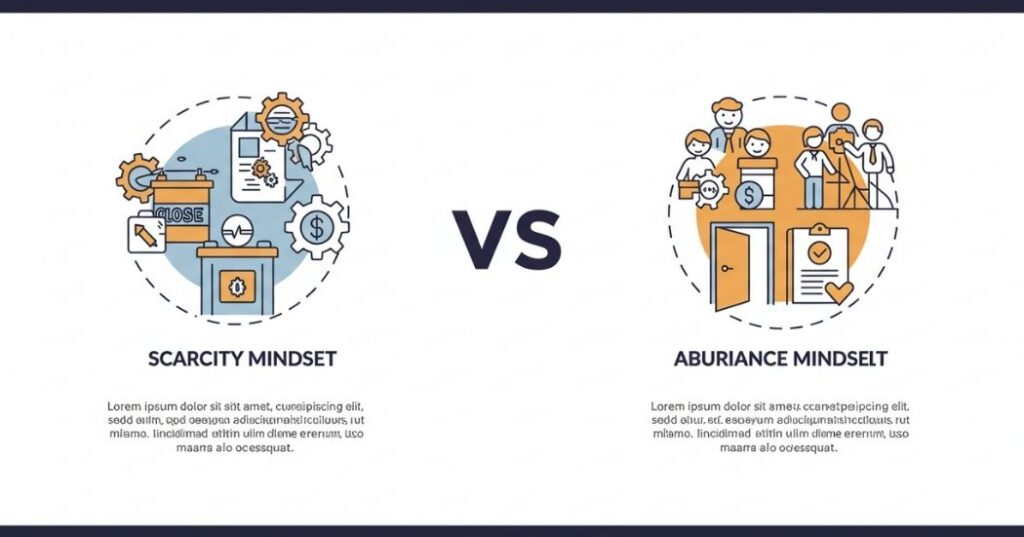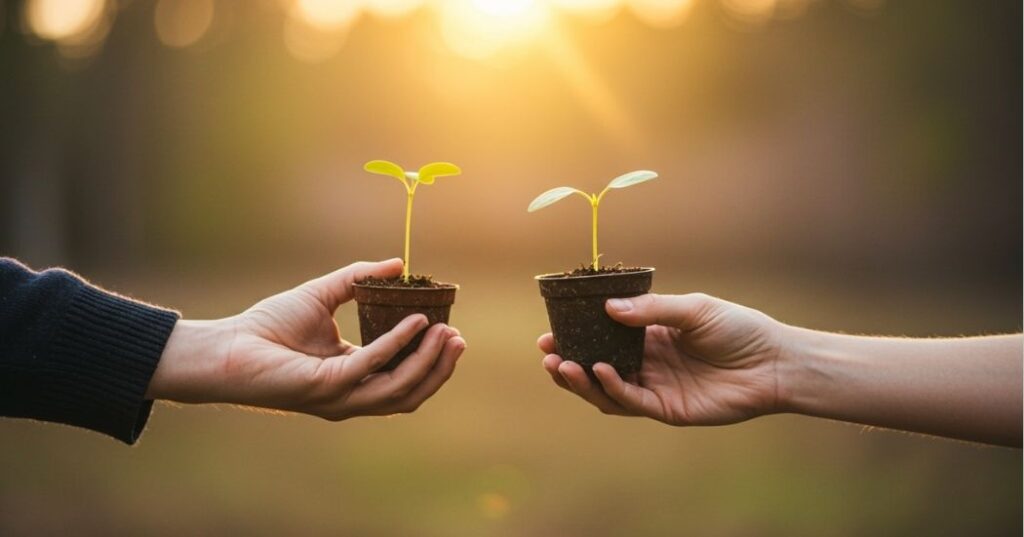Do you constantly feel like there’s not enough—not enough time to get things done, not enough money to feel secure, not enough opportunity for you to truly thrive? Do you find yourself stressed about what you lack, comparing yourself to others, or fearing that taking a risk might lead to losing what little you have?
That’s the scarcity mindset talking—a pervasive and often subconscious belief system that frames the world as a place of limitation and lack. It’s more common than you might think, subtly influencing our decisions, stress levels, and overall well-being. But the good news? Your mindset is not fixed. You can consciously train your brain to move beyond these limitations and cultivate a perspective rooted in abundance.
This guide will help you understand the fundamental differences between a scarcity and an abundance mindset, why this shift is critical for your growth, and most importantly, provide daily practical exercises that can help you actively rewire your thinking towards possibility, peace, and profound progress.
What Is Scarcity vs. Abundance Mindset?

Our mindset is the lens through which we perceive and interpret the world. It shapes our thoughts, feelings, and actions. Understanding the distinction between scarcity and abundance is the first step in choosing a more empowering perspective.
A scarcity mindset, often rooted in fear, is the underlying belief that resources—be it money, time, love, opportunities, or success—are limited and finite. If someone else gets a piece of the pie, it means there’s less for you. This perspective often sounds like:
- “There’s just not enough to go around for everyone.”
- “If they win, it inherently means I lose, or there’s less for me.”
- “I’ll never have enough time to do what truly matters / enough money to feel secure / enough support to pursue my dreams.”
- “I have to hoard what I have because I might not get more.”
- “Opportunities are rare, and I have to fight for every little bit.”
An abundance mindset, by contrast, stems from a place of trust, gratitude, and a belief in possibility. It operates on the principle that the world is full of opportunities, resources, and potential for growth, and that success is not a zero-sum game. It believes:
- “There’s always more to learn, create, give, and grow. Resources can be generated.”
- “I have the power to create opportunities and solutions.”
- “Someone else’s success can be inspiring and doesn’t diminish my own chances; in fact, it can expand possibilities for everyone.”
- “There is plenty, and sharing what I have actually attracts more.”
- “Life is full of possibilities, and new opportunities are always emerging.”
This fundamental difference in outlook doesn’t just change how you feel; it changes how you act and what you attract into your life.
Why This Shift Matters So Profoundly
Moving from a scarcity to an abundance mindset isn’t just about “thinking positive”; it’s about fundamentally rewiring your approach to life, which has tangible impacts. Studies in positive psychology and neuroscience (Seligman, 2011; Dweck, 2006) show that our core beliefs about possibility directly shape our stress response, risk-taking behavior, problem-solving abilities, and overall resilience.
Cultivating an abundance mindset significantly increases your:
- Decision-making clarity: When you believe in abundant possibilities, you’re less likely to make fear-based, reactive decisions. You can assess situations with a clearer head, focusing on potential gains rather than just loss prevention, leading to more strategic and aligned choices.
- Capacity to take creative action & embrace opportunities: An abundance mindset fuels proactivity. Believing that opportunities are plentiful and that you can create them makes you more likely to take calculated risks, innovate, and step outside your comfort zone—actions essential for growth and achievement.
- Resilience in the face of setbacks: When you believe that setbacks are learning opportunities and that new chances will arise, you bounce back from adversity more quickly and with greater strength, rather than seeing a failure as proof of limited resources or personal inadequacy.
- Collaboration and Connection: An abundance mindset allows you to celebrate others’ successes and collaborate more freely, knowing that there’s enough for everyone. This fosters stronger relationships and opens doors to synergistic partnerships.
- Long-term fulfillment and well-being: True fulfillment often comes from growth, contribution, and connection. An abundance mindset supports these by encouraging continuous learning, generosity, and a positive outlook, leading to deeper satisfaction beyond mere material accumulation.
Ultimately, this shift empowers you to live a more proactive, joyful, and expansive life.
6 Practical Exercises to Shift Into Abundance
Shifting your mindset is an active process that requires consistent practice. These exercises are designed to be integrated into your daily or weekly routine to help you retrain your brain.
1. Daily Gratitude Journaling (The “3-1-1” Method)
This simple yet powerful practice retrains your brain to focus on what you have rather than what you lack, actively countering the negativity bias (Emmons & McCullough, 2003).
Start or end your day by writing down:
- 3 specific things you’re genuinely grateful for today (e.g., a warm cup of coffee, a supportive conversation, a moment of quiet). Be specific.
- 1 thing you created, contributed, or accomplished today (e.g., finished a report, offered a helpful suggestion, cooked a nourishing meal). This acknowledges your agency.
- 1 resource you already possess that supports you (e.g., a particular skill, a supportive friend, access to information, a comfortable home). This highlights existing abundance.
This daily ritual anchors your awareness in the present good, building a foundation of appreciation from which abundance can grow.
2. “Both/And” Thinking Practice
Scarcity often thrives on black-and-white, either/or thinking (e.g., “I can either have a successful career or a fulfilling personal life”). Abundance thinking allows for complexity, nuance, and integration.
Practice rewriting these binary thoughts into “both/and” statements:
- Instead of: “I can either rest or be successful.”
Try: “I can be resting and simultaneously making progress towards my long-term success by recharging.” - Instead of: “I can be honest or keep this relationship.”
Try: “I can be honest with compassion and strengthen this relationship through authentic communication.” - Instead of: “I am either an expert or a learner.”
Try: “I can be knowledgeable in some areas and always learning and growing in others.”
Catch yourself in binary thinking throughout the day and consciously practice finding the “both/and.” This expands your sense of possibility.
3. Reframe “Not Enough” Stories & Challenge Scarcity Scripts
Become an observer of your internal dialogue. When you catch scarcity scripts running in your mind, consciously challenge and reframe them.
The process:
- Identify the Trigger: What situation or thought sparked the scarcity feeling?
- Acknowledge the Feeling: Name the emotion (e.g., anxiety, fear, envy).
- Catch the Scarcity Script: What’s the exact thought? (e.g., “I’m running out of time,” “I don’t have the skills for this,” “Everyone else is getting ahead of me.”)
- Challenge & Reframe: Question the absolute truth of the script and create a more empowering, abundance-oriented alternative.
Examples:
- Scarcity Script: “I’m running out of time to achieve my goals.”
Abundance Reframe: “I am using the time I have intentionally and effectively. I trust my journey’s timing.” - Scarcity Script: “There are so few good opportunities in my field.”
Abundance Reframe: “New opportunities are always emerging, and I am capable of creating or attracting the right ones for me.” - Scarcity Script: “I can’t afford to invest in that course/tool right now.”
Abundance Reframe: “I am resourceful and can find creative ways to access the knowledge/tools I need, or I can prioritize this as a valuable investment in my future abundance.”
4. Intentional Acts of Generosity (Weekly)

Generosity is a powerful antidote to scarcity. When you give freely, without expectation of direct reciprocation, you reinforce the belief that you have enough (and more) to share. This reprograms your brain to perceive and operate from a place of surplus.
Each week, intentionally practice an act of generosity:
- Give your time: Mentor someone, actively listen to a friend in need, volunteer for a cause you believe in.
- Offer genuine praise or acknowledgment: Publicly thank a colleague, write a positive review, send an appreciative note.
- Share resources or knowledge: Forward a helpful article, share a useful tool or idea, offer your expertise.
- Perform small acts of kindness: Hold a door open, let someone go ahead in line, offer a genuine smile.
The key is the intention and the lack of expectation for something in return.
5. Abundance Visualization & Embodiment (5-10 Min Daily)
Visualization is a technique to mentally rehearse and emotionally connect with desired states. By vividly imagining abundance, you begin to create the neural pathways and emotional resonance that attract it.
Sit quietly, close your eyes, and for 5-10 minutes, vividly imagine:
- Opportunities, ideas, and positive connections flowing effortlessly to you. Feel the excitement and gratitude.
- Your creativity and unique talents attracting aligned partners, clients, or projects. See yourself collaborating successfully.
- Your future self calmly and confidently navigating growth, handling challenges with ease, and enjoying a sense of peace and plenty. What does that look and feel like in detail?
- A specific goal achieved, not just the outcome, but the feelings of accomplishment, joy, and gratitude associated with it.
Engage all your senses. What do you see, hear, feel, even smell or taste in this abundant reality? The more vivid and emotionally charged the visualization, the more powerful its effect.
6. Mindful Audit of Your Inputs & Environment
Your environment—including the information you consume, the people you interact with, and your physical surroundings—profoundly influences your mindset. Consciously curate these inputs to support an abundance mentality.
Regularly review your:
- Media Consumption: News feeds, social media, podcasts, books. Ask: “Is this content predominantly highlighting problems and lack (scarcity), or is it focused on solutions, inspiration, and growth (abundance)?” Unfollow or limit exposure to fear-mongering or overly negative sources.
- Relationships & Conversations: The people you spend time with. Ask: “Do these interactions leave me feeling drained and focused on limitations, or energized and expansive?” Seek out supportive, optimistic individuals and limit time with chronic complainers or those who reinforce scarcity beliefs.
- Physical Environment: Your workspace, your home. Ask: “Does my environment feel cluttered and chaotic (reflecting internal scarcity) or clear, organized, and inspiring (reflecting internal abundance)?” Declutter and create spaces that feel uplifting.
Actively choose inputs that nourish an abundance mindset.
Real Life Example: Dana’s Shift from Financial Anxiety to Flow
Dana, a talented freelance writer, was constantly plagued by financial anxiety. She undercharged for her work, hesitated to pursue bigger clients for fear of rejection, and lived with a persistent feeling that there “wasn’t enough” business to go around, leading to overwork and near burnout.
Her coach introduced her to daily gratitude journaling focusing on her existing skills and past successes, and weekly “generosity acts” where she offered free 15-minute consultations to aspiring writers. The gratitude practice helped Dana recognize the immense value and skills she already possessed. The act of giving her time generously, without immediate expectation of return, shifted her internal belief from “I don’t have enough” to “I have valuable expertise to share.”
This internal shift had external results. Dana started pricing her services with more confidence, attracted clients who valued her expertise more highly, and her referral network grew. Within 30 days of consistently practicing these exercises, she not only felt significantly less anxious about money but also found her client base doubling, allowing her to work more selectively and joyfully, without the previous sense of desperate hustle.
Bonus Resource: Abundance Affirmations to Practice
Affirmations are positive statements that, when repeated with conviction and emotion, can help rewrite limiting subconscious beliefs. Say them aloud, write them down, or use them as a mantra throughout your day. Consistency is key.
- “I create significant value and, in turn, I receive abundant value in many forms.”
- “There is always enough time, energy, and resources for what truly matters to me.”
- “I am open and receptive to unexpected opportunities, synchronicities, and blessings.”
- “My capacity for joy, love, and success is limitless.”
- “I celebrate the abundance around me and within me.”
Final Thoughts
Shifting from a scarcity to an abundance mindset is not about ignoring real-world challenges or pretending problems don’t exist. It’s about consciously choosing your perspective and recognizing your power to influence your reality by changing your internal state. It’s understanding that even amidst challenges, opportunities for growth, learning, and contribution abound.
Start small with one or two of these exercises. Practice them with intention and consistency. Be patient with yourself; unlearning old patterns takes time. But as you do, you’ll begin to notice subtle shifts—in your thoughts, your feelings, your decisions, and ultimately, in the opportunities and experiences that flow into your life. Let that ripple of abundance begin today.
Ready to dive deeper and accelerate your mindset transformation? Explore our guided journal and comprehensive mindset rewiring course specifically built to help you cultivate lasting abundance.
Related Reading: Mindset Coaching Techniques to Unlock Creativity for Entrepreneurs
📚 References
- Seligman, M. E. P. (2011). Flourish: A Visionary New Understanding of Happiness and Well-being.
https://www.amazon.com/dp/1439190763 - Brown, B. (2012). Daring Greatly: How the Courage to Be Vulnerable Transforms the Way We Live, Love, Parent, and Lead.
https://www.amazon.com/dp/1592408419 - Cameron, J. (2002). The Artist’s Way.
https://www.amazon.com/dp/1585421464 - Emmons, R. A., & McCullough, M. E. (2003). Counting blessings versus burdens: An experimental investigation of gratitude and subjective well-being in daily life. Journal of Personality and Social Psychology, 84(2), 377–389.
https://doi.org/10.1037/0022-3514.84.2.377

